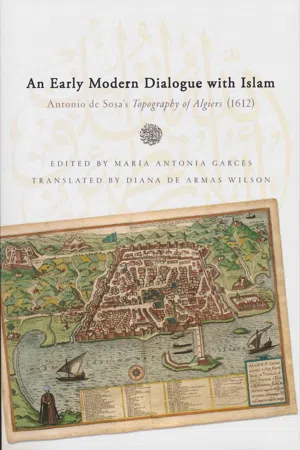
Early Modern Dialogue with Islam
Antonio de Sosa's Topography of Algiers (1612)
- 536 pages
- English
- PDF
- Available on iOS & Android
Early Modern Dialogue with Islam
Antonio de Sosa's Topography of Algiers (1612)
About This Book
An Early Modern Dialogue with Islam: Antonio de Sosa's Topography of Algiers (1612) makes available in translation a riveting sixteenth-century chronicle of European and North African cultural contacts that is virtually unknown to English-speaking readers. The Topography was written by a Portuguese cleric, Doctor Antonio de Sosa, who was captured by Algerian corsairs in 1577 and held as a Barbary slave for over four years while awaiting ransom. Sosa's work is a fascinating description of a city at the crossroads of civilizations, with a sophisticated multilingual population of Turks, Arabs, Moriscos, Berbers, Jews, Christian captives, and converts to Islam from across the world.
In the Topography of Algiers, Sosa meticulously describes the inhabitants' daily lives; their fashions, pastimes, feasts, and funerals; their government; the landmarks of the city itself; and much more. Readers will be struck by the vibrancy of his narrative, rendered into English with crisp accuracy by Diana de Armas Wilson. The Topography is a treasure trove of amazing customs, startling behavior, and historical anecdotes that will enthrall readers. The extensive introduction by María Antonia Garcés is a superb archival study of the Mediterranean world described by the Topography, as well as an exposé of the adventurous, even scandalous, life of its author. The introduction also discusses the fraudulent publication of Sosa's Topography under another man's name.
Sosa's chronicle stands out for its complexity, vitality, and the sharpness of the author's ethnographic vision. No other account of captivity in this period offers such a detailed and dynamic tableau of Algerian society at the end of the sixteenth century.
Frequently asked questions
Information
Table of contents
- Cover
- Half title
- Series page
- Title page
- Copyright
- Dedication
- Contents
- Illustrations
- Transliteration and Translation
- Note from the Translator
- Acknowledgments
- Introduction
- Preliminary Materials
- Chapter 1: The Founding of Algiers
- Chapter 2: Why the City Is Called Algiers
- Chapter 3: Algiers as a Muslim Kingdom
- Chapter 4: How Algiers Came under the Turks
- Chapter 5: The Ramparts of Algiers
- Chapter 6: The Gates of Algiers
- Chapter 7: The Fortifications of Algiers
- Chapter 8: The Moat of Algiers
- Chapter 9: The Castles and Forts outside Algiers
- Chapter 10: The Houses and Streets of Algiers
- Chapter 11: The Inhabitants and Neighbors of Algiers
- Chapter 12: Turks
- Chapter 13: Renegades
- Chapter 14: Ka’ids
- Chapter 15: Sipahi
- Chapter 16: Janissaries
- Chapter 17: Agha of the Janissaries
- Chapter 18: Ranks of the Janissaries
- Chapter 19: Customs of the Janissaries at War
- Chapter 20: Customs of the Janissaries in Peacetime
- Chapter 21: Customs of the Algerian Corsairs
- Chapter 22: Catalogue of Corsairs
- Chapter 23: Corsairs with Frigates
- Chapter 24: Algerian Merchants
- Chapter 25: Algerian Laborers and Artisans
- Chapter 26: Algerian Fashions
- Chapter 27: The Marabouts of Algiers
- Chapter 28: The Jews of Algiers
- Chapter 29: Languages and Currencies
- Chapter 30: Marriage Ceremonies
- Chapter 31: Childbirth and Child Rearing
- Chapter 32: Algerian Women’s Fashions
- Chapter 33: Women’s Pastimes, Home Decorating, and Cooking
- Chapter 34: Islamic Feast Days and Festivals in Algiers
- Chapter 35: A Miscellany of Muslim Customs in Algiers
- Chapter 36: Algerian Vices
- Chapter 37: Algerian Virtues
- Chapter 38: Death and Burial in Algiers
- Chapter 39: Algerian Buildings and Fountains
- Chapter 40: The Natural Beauty of Algiers
- Chapter 41: The Government of Algiers
- Abbreviations
- Glossary
- Notes
- Archival Sources
- Bibliography
- Index